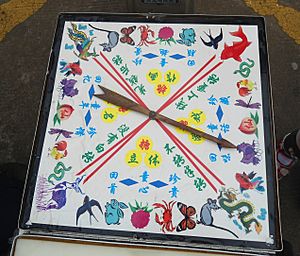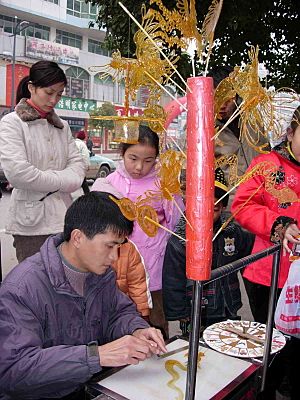Sugar painting facts for kids
Sugar painting (糖画) is a special kind of Chinese folk art. It uses hot, melted sugar to create flat pictures on a smooth surface, like marble or metal. An artist uses a small ladle (a type of spoon) to drizzle the liquid sugar. Once the sugar cools down and becomes solid, it's carefully removed with a spatula and stuck onto a bamboo stick. Sometimes, artists can even make 3D sugar sculptures by layering pieces of cooled sugar!
Contents
A Sweet History
Sugar painting might have started a long, long time ago during the Ming dynasty. Back then, important families and government officials would make small sugar animals for religious ceremonies. This art became very popular!
Later, Chinese folk artists got even better at it. They started mixing sugar painting with other cool art forms, like shadow play (telling stories with shadows) and paper cutting. This helped them create many different and exciting sugar designs.
In a place called Sichuan during the Qing dynasty, artists made a big change. Instead of using molds, they started using the small ladle we see today to draw with the sugar.
Today, sugar painting shows how clever and creative Chinese people are. To keep this amazing art alive, the government has even listed it as a special "Non-Material Culture Heritage." This means it's an important part of their culture. Famous sugar painting artists are now invited to other countries, like Japan and Spain, to show off this unique Chinese art!
How Sugar Paintings Are Made
Making a sugar painting usually involves four main steps:
- Boiling the sugar syrup until it's just right.
- "Painting" the design onto a flat surface.
- Attaching the sugar art to a stick.
- Carefully lifting it off the surface.
If an artist wants to make a 3D sugar figure, they will use several flat sugar pieces that were made earlier.
Artists drizzle the hot, melted sugar from a small ladle onto a smooth, flat surface, often white marble or metal. First, they create the main outline of the picture with a thicker stream of sugar. Then, they add thinner lines of sugar inside to fill in the shape. These lines can be swirls, zig-zags, or other cool patterns.
When the design is finished, a thin wooden stick is attached to the sugar art with a bit more hot sugar. While the sugar is still a little warm and flexible, the artist uses a spatula-like tool to gently lift the sugar painting from the surface. Then, it's ready to be sold or put on display!
In 2012, special machines started appearing that can make sugar paintings automatically! You just add the sugar, and the machine is programmed to draw the designs. It's a bit like an automatic engraver. These machines don't need any art skills to use, and they can create hundreds of different pictures.
A Sweet Story
Some people say that sugar painting was invented by a Chinese writer named Chen Zi'ang during the Tang Dynasty. He really loved to eat brown sugar. But he wanted to enjoy it in a special way, almost like an artwork. So, he melted the sugar and poured it into molds to shape it.
One day, as he was holding a sugar shape, the prince saw it and wanted it. The prince took it to the emperor, who thought it was a very interesting invention! The emperor praised Chen Zi'ang and even gave it a name: "sugar pancake." Soon, this sweet snack became very popular in the palace.
After leaving the palace, Chen Zi'ang shared this technique in his hometown, which is now in Sichuan province. Because the emperor liked it so much, this art and food quickly became famous and grew into the sugar painting we know today!
Fun Sugar Art Designs
Sugar painting is super popular, especially with kids! Customers often choose their design by spinning an arrow on a wheel. The arrow lands on a random picture, usually a popular animal like a duck, fish, monkey, dog, or bird.
But you can also ask for a custom design! Common sugar paintings often show things that symbolize good luck or famous characters from Chinese classical novels. For example, artists can create:
- Chinese mythical creatures (like dragons!)
- Chinese gods
- Characters from Chinese opera (like brave warriors)
- Plants (such as beautiful flowers)
- Everyday objects (like bicycles)
- Symbols of good fortune (like the dragon and phoenix)
Almost anything can be painted, depending on how skilled and creative the artist is!
Where to Find Sugar Painting
You can find authentic sugar painting in Sichuan province, where it has a long history. But because it has become more and more popular, you can now also find it in other parts of China, like Henan, Tianjin, and Beijing.



